Writing advice and book reviews brought to you by someone who loves words almost as much as you do.
Don't wanna be here? Send us removal request.
Text
These are really fun to look at to spice up your writing
Using Rhetorical Devices in Your Writing
Using Rhetorical Devices in Your Writing
by ARHuelsenbeck
Whether you write fiction, non-fiction, or poetry, rhetorical devices are among your most useful tools. Use them, and your writing will have specificity, emotional impact, color, and memorability.
(more…)
View On WordPress
41 notes
·
View notes
Text
Writing Advice Bilingual Characters
As some of you (who read my reviews) already might have noticed, I am bilingual myself. Sadly, multilingual people do not get represented well a lot in media, so yeah… some advice for writing them. It will certainly not capture every aspect of being bilingual, but it might give you a first idea.
There are different ways to be multilingual.
People who grew up with more than one native language will almost certainly speak all of them fluently. Most of them have two (their parents’ language and their country’s language, or the language of one parent and of the other) but I also know a family where the children grew up with four native languages (the mother speaks Portuguese, the father Italian, they talk to each other in English, and live in Germany, where the children grew up)
Some people speak two or more languages, but cannot write all of them - especially when the alphabets are not the same, for example English and Russian or Arabic. This affects mostly children of immigrants.
Some people can read and write a language quite well, but are not good at speaking or listening comprehension. Those people often learned the language at school with a bad teacher or by themselves with books and apps.
Some people, again mostly children and grandchildren of immigrants, can read and understand a language, but don’t speak it. Mostly, the parents decided to not teach the child the language, and they learned it themselves by listening to their parents talk to relatives.
Confidence can play a big role in this. I understand the dialect of my grandparents without a problem, but I would never try to speak it. I can’t even imagine forming those words with my mouth, and it would sound terrible.
People who learnt a language at school can reach completely different levels of that language. I started learning English at age 6 and am completely fluent by now. Other people in my class barely understand more than easy conversations in English.
Most people will do their very best to hide their accents.
If the person is not a native speaker, but fluent in a language, their accent will be a mix of whatever they can find at the moment. Media is a big influence in that.
Since I watch more British than American TV, my accent sounds a bit british, too. When I watched “Call the Midwife”, I often even unconciously copy the accent of Laura Main. I don’t know why her, but my brain just liked it, I guess.
Also, we will use words, phrases and sentence structures from so many different sources.
People who learnt English through the internet (aka most of the younger generation) will have problems to not use swear words when actually being in Great Britain or America. They just do not have the weight for us, since on the internet they get used all the time.
I have never in my whole live heard a multilingual person switch languages mid-sentence on accident.
We will do it on purpose, though, if the other part of the conversation understands both languages.
Also, we will maybe say the word in another language if we forget the meaning.
Multilingual people that are not natives in the language they usually use in their day-to-day life (immigrants, for example) will often count and calculate in their native language. For example at a restaurant where they calculate the price in their head, they will probably do it in their native language.
Conversations with multiple multilingual people can be very different.
If one person only understands one language, they will probably try to include that person by speaking the language they share. I can say from experience, though, that if eight native Germans that have varying levels of English language skills will sit together with one introverted Turkish person with medium English language skills, they will go back to German quite often. It’s not nice, but sadly natural.
In general, people will try to speak in their native language if possible. You can take two people that share a native language and also both speak English and let them walk around in London - they will probably speak their native language, no matter how well they speak English.
Multilingual people that share multiple languages will switch on purpose when they feel like they can express their thoughts better in the other language.
Many languages have taken words from English.
Especially young people take a lot of English filler words and phrases (or insults) and put them into their native language. “Help, mein Deutschlehrer überfordert uns mit Hausaufgaben, like, what the fuck, glaubt der wir haben nichts besseres zu tun?” Is a sentence you would absolutely hear from a German student.
Many young people that don’t live in Great Britain or America will not use these words and phrases around their parents. First of all, our parents often do not speak English as well as we do, but more importantly, our parents do not like us using English instead of ur native language.
Many professions nowadays have an English name, I don’t know why. What used to be a Hausmeister is now a Facility Manager. The longer the English phrase for your profession, the more likely you will not be taken serious by older people.
Once you have more than one native language, you learn new languages more easily, for some reason. I know a girl that speaks 7 languages, at age 20, 5 of them fluently.
“You speak English quite well” or phrases like that said by a native speaker can be the best compliment ever, or more uncomfortable than nice.
When you are translating for your family and hear that sentence, it is super nice.
When you are only speaking English, that sentence indicates that your accent is still heavy. You do not pass as a native speaker.
When you are a native speaker, that sentence is just weird.
You can indentify the people that learnt a language through reading by giving them words that are pronounced untypically.
For years I thought “precious” (a word that is heavily used on the internet, especially in fan communities, but not that much in school) was pronounces pree-ci-ous. I was shocked when I heard it for the first time.
There are situations where even quite fluent non-native speakers will not be able to understand or talk in their second language.
The first few minutes after standing up (although that can change when the person is really fluent)
When they are in great pain
When they are in great fear
When they are under great stress
Sometimes even when they did not use that language in the last few days
Translating in realtime is terribly hard and will fuck your head. When I was on holiday with my parents, I often had to read the information signs in museums or at sights for them and translate. It’s easier when you first read the text and then summarise it in another language, but trying to translate it sentence by sentence is painful and you will question your abilities in both languages.
This gets just more horrible when under pressure. While we were in England, a visibly stressed young woman came to us and asked us if we had 5 pounds, she had lost some money she needed to take the train back home. I repeated her sentence to my father. In English.
Also sorry to the poor worker at McDonalds who I talked English to while speaking German to my English exchange student.
People abroad will absolutely become friends with every person that they hear speaking their language. While being in London, we overheard a man talking to his son in German about taking a photo, and I immediately asked (in German) if I should take a photo of both of them together. We talked for fifteen minutes after that, even though we had never met before.
On that note, in tourist citys the people that try to sell things to tourists usually speak a lot of languages enough to say things like “Oh, I speak a bit of [language], too, but not well. Didn’t pay enough attention in school. You look like nice people.” Makes it so easy to sell things.
Idioms are literally hell. Best example has been in the news currently, with Greta Thunberg literally translating a Swedish idiom in a tweet not realising that “putting someone against a wall” means something totally different in English.
Idioms will be hell for you as a writer, too, though, as long as you do not fluently speak both of the languages or at least one of them is fictional, because it’s quite easy to mess up if you use idioms that jus aren’t normally used by people speaking that language.
Bilingual puns are amazing, but sadly rare.
Those are the things I thought of first… Maybe you can find some ideas or inspiration there for your characters, too. The best thing of course is to let someone proof-read your character if you are uncertain, but this hopefully already helped you a bit!
4K notes
·
View notes
Text
A List of Negative Character Traits
Ah, characters. A writer’s children. We love to treat them, give them fun friends and wacky adventures, and 𝕞𝔸𝕜𝔼 𝕥ℍ𝕖𝕀𝕣 𝕃𝕚𝕍𝕖𝕊 𝕒 𝕃𝕚𝕍𝕚ℕ𝕘 ℍ𝕖𝕃𝕝. But of course, the protagonist of the story HAS to be perfect to survive such trials, right? Wrong! Nobody is perfect, and for a character to feel real and relatable to the readers, they have to be flawed. Flaws are what make us human! But when you really love your characters…it can be hard to come up with flaws that don’t make them seem like a bad person to you. All of them just seem so extreme! Here’s a nice list of ideas to get you started in truly perfecting you character:
Selfish
Stubborn
Loud
Gossip
Bossy
Proud
Rude
Thoughtless
Vain
Cowardly
Keep reading
#writing advice#boldly go writing advice#writing community#character development#writing novel writing
32 notes
·
View notes
Text
Some Thoughts on Dialogue
Last night, I was thinking that I might just have enough writing experience to give writing advice. So this is my first attempt at such a post. My genres of choice are fanfic, fantasy, and science fiction, so my advice will probably reflect that fact. I hope it comes across as useful to someone. So, without further ado: some thoughts of dialogue.
First, and most basic: only one speaker per paragraph. You can have a short paragraph that’s nothing more than the word, “Hi,” or you can have a long piece of dialogue, or you can have long description or action with a bit of dialogue in it—but only one speaker per paragraph.
For an example of what not to do:
“Isn’t it a nice morning?” she chirped. It was annoying this early, and John wished she’d go away. “Don’t see what’s so nice about it.”
You can see, I hope, how this creates a lot of confusion about who’s saying the second bit of dialogue. So, you bump John and his need for coffee to the next paragraph.
You can get away with having them in the same paragraph if you don’t actually give John’s dialogue as actual dialogue. Like so:
“Isn’t it a nice morning?” she chirped. John didn’t think it was a nice morning, and said so.
So, now that we’ve established that we only do one speaker per paragraph, what about how to tag it? (Under the read-more)
Keep reading
90 notes
·
View notes
Note
Ok so- I used to write mostly fanfictions, but since a while I stopped bc I wanted to create original stuff. And idk, I feel really lost and insecure rn. I create OCs but - no matter how much I try - I still can't put them in a story. I start writing random one shots but always leave them incomplete. Lately I've been trying with poetry too, but I feel like I suck at that too. Some advice please??? I've been writing since I was 6 and it sucks to feel so unable now aaAAA (sorry for my bad english)
I think you just need some time to relax. Your writing isn’t bad, you don’t suck, and you aren’t lost. You’ve just realized there’s room for improvement, and if you’ve been writing since you were little (me too, by the way!) then you didn’t see the need for improvement until you grew up. That’s 100% normal and to be expected. It’s actually admirable because some people never realized they could be better. Like, some popular writers still write like they just learned how and I guess they’re cool with that. You’ve advanced and you’re right where you need to be.
Pick a problem you see with your writing, whether it’s losing motivation or lacking plot ideas, and research how best to fix that problem. One weakness at a time, work on it. Your writing will gradually improve and you will gradually feel better about it. It will never be perfect once you know it can be better, but that’s good too. As long as writing makes you happy, keep practicing.
If it’s easier, look up writing prompts and write how your characters would act in those situations. Expand on some of those ideas, giving them a beginning-middle-end structure. It can be as short as a couple paragraphs, or it can surprise you and last a couple pages. And the best advice for giving characters stories is to figure out what your characters want. Do they want to get married? Have a great career? Protect their family? Buy a nice house? Go to a party? Make a friend? Give them short-term goals if you don’t know what their long-term ones might be yet, and write a story about how they achieve those goals.
And let me know if there’s anything else I can help you with!
67 notes
·
View notes
Text
Writing Tip: Don’t Be Afraid of Mixing Dialogue and Action
So I’ve been reading a lot of amateur writing lately, and I’ve noticed what seems to be a common problem: dialogue.
Tell me if this looks familiar. You start writing a conversation, only to look down and realize it reads like:
“I’m talking now,” he said.
“Yes, I noticed,” she said.
“I have nothing much to add to this conversation,” the third person said.
And it grates on your ears. So much ‘said.’ It looks awful! It sounds repetitive. So, naturally, you try to shake it up a bit:
“Is this any better?” He inquired.
“I’m not sure,” she mused.
“I definitely think so!” that other guy roared.
This is not an improvement. This is worse.
Now your dialogue is just as disjointed as it was before, but you have the added problem of a bunch of distracting dialogue verbs that can have an unintentionally comedic effect.
So here’s how you avoid it: You mix up the dialogue with description.
“Isn’t this better?” he asked, leaning forward in his seat. “Don’t you feel like we’re more grounded in reality?”
She nodded, looking down at her freshly manicured nails. “I don’t feel like a talking head anymore.”
“Right!” that annoying third guy added. “And now you can get some characterization crammed into the dialogue!”
The rules of dialogue punctuation are as follows:
Each speaker gets his/her own paragraph - when the speaker changes, you start a new paragraph.
Within the speaker’s own paragraph, you can include action, interior thoughts, description, etc.
You can interrupt dialogue in the middle to put in a “said” tag, and then write more dialogue from that same speaker.
You can put the “said” tag at the beginning or end of the sentence.
Once you’ve established which characters are talking, you don’t need a “said” tag every time they speak.
ETA: use a comma instead of a period at the end of a sentence of dialogue, and keep the ‘said’ tag in lower caps. If you end on a ? or !, the ‘said’ tag is still in lower case. (thanks, commenters who pointed this out!)
Some more examples:
“If you’re writing an incomplete thought,” he said, “you put a comma, then the quote mark, then the dialogue tag.”
“If the sentence ends, you put in a period.” She pointed at the previous sentence. “See? Complete sentences.”
“You can also replace the dialogue tag with action.” Extra guy yawned. “When you do, you use a period instead of a comma.”
So what do you do with this newfound power? I’m glad you asked.
You can provide description of the character and their surroundings in order to orient them in time and space while talking.
You can reveal characterization through body language and other nonverbal cues that will add more dimension to your dialogue.
You can add interior thoughts for your POV character between lines of dialogue - especially helpful when they’re not saying quite what they mean.
You can control pacing. Lines of dialogue interrupted by descriptions convey a slower-paced conversation. Lines delivered with just a “said” tag, or with no dialogue tag at all, convey a more rapid-fire conversation.
For example:
“We’ve been talking about dialogue for a while,” he said, shifting in his seat as though uncomfortable with sitting still.
“We sure have,” she agreed. She rose from her chair, stretching. “Shall we go, then?”
“I think we should.”
“Great. Let’s get out of here.”
By controlling the pacing, you can establish mood and help guide your reader along to understanding what it is that you’re doing.
I hope this helps you write better dialogue! If you have questions, don’t hesitate to drop me an ask :)
41K notes
·
View notes
Text
Writing tip from my old middle school history teacher:
Pronouns are sin.
Circle in red every single pronoun used after your first draft. Go back and rework each sentence to take out any unnecessary pronouns. Occasionally you'll find ones that must stay to make the sentence work but most of the time you can change the format around to not include it. Your writing will feel more put together and thought out. Nothing is more frustrating than reading a story with 50+ I's he's or she's in one page.
Its been over 10 years and this is still a tip I use.
3 notes
·
View notes
Note
I was wondering if you knew any basic guides to outlining a novel for the first time?
Outlining a story is very, very important. Without an outline and thorough planning, your story will veer off in wildly different directions and will cost you a ton of time editing later, like my book did.
1. Get the characters down first
Characters are like the chess pieces of the story. Their moves and strengths/weaknesses will decide what is going to happen and how it will happen. Sure, you can have a nice plot and setting, but without the characters, the story is meaningless.
Here is the character chart that I usually use:
Name (First/Middle/Last/Maiden name)
Aliases/Nicknames
Age
Race
Gender
Sexuality
Height
Weight
Eye color
Hair color
Clothing style
Religion
Political views
Personality Traits
Strengths and Weaknesses
Likes and Dislikes
Family
Friends
Enemies
Role in the story
Backstory/past
2. Choose a template
Just bulleting the events does not give the plot the dimension that it deserves and does not really accommodate side plots.
I personally use the zigzag method that I discovered from this post. I branch off of the zigzags for my side plots so it looks kind of like a graph.
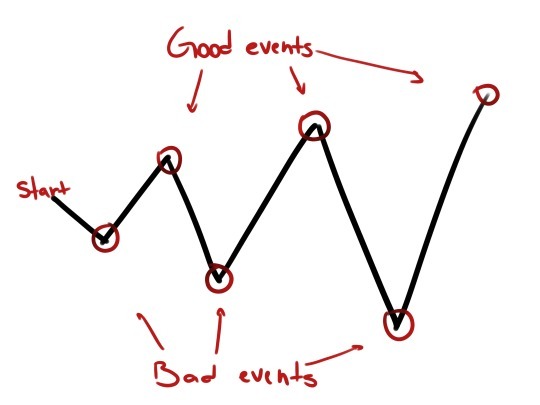
You can also use the subway method, which I found on the nanowrimo website.
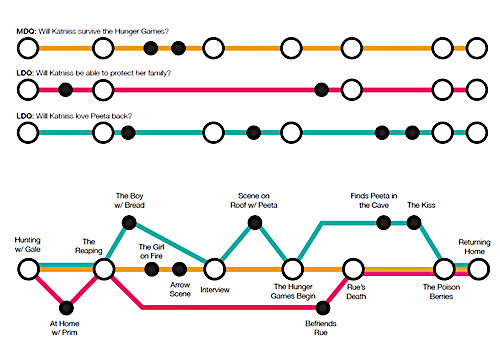
There are a whole other host of outlines to choose from if you search them up!
3. Know that you don’t have to stick to it
An outline is just that: an outline. It’s not the final decision for the plot, it’s the first draft for the plot. If you’re writing and one of the points just isn’t working anymore, you don’t have to keep it because it was a part of your outline.
Write what feels right.
Happy outlining, and good luck with your story!
#boldly go writing advice#boldly go writing#writing advice#writing tips#writeblr#novel writing#creative writing advice
10K notes
·
View notes
Text
YES THIS IS S U P E R HELPFUL
Writers, I cannot stress this enough.
Read your work aloud.
It’s one thing to read your words on the page over and over again until they have the same internal monotonous sound. It’s another to hear them in your own voice.
Word even has a handy feature where it will read your highlighted text to you; I use it often. Google docs and scrivener might?? have something similar.
The point of hearing the words as opposed to reading them in your head is you get the finest feel of your own movement. If your writing is stagnant or awkward, often times you will not notice on your own. Someone will either have to point it out to you (which involves being comfortable enough to share you work and receive concrit, as well as finding someone willing to give that cut and dry feedback), or you can realize it on your own by reading the text.
I cannot overstate this enough. It’s a vital tool that should be kept in any writer’s toolbox.
Read your words aloud. Get the feel of them. Find your ridiculous sentences, find your good ones, find the beautiful run-ons you can keep and the messy ones you need to chop. Read your words aloud.
155 notes
·
View notes
Text
The 15 PLOT POINTS of Story Structure
To all the writers who have ever been told they need to outline their story, and privately thought “Great. But how do you DO that? What exactly does that mean?! Is there a map? WHAT IS THE SPECIFIC DEFINITION OF THE VAGUE WORD ‘OUTLINE’?”
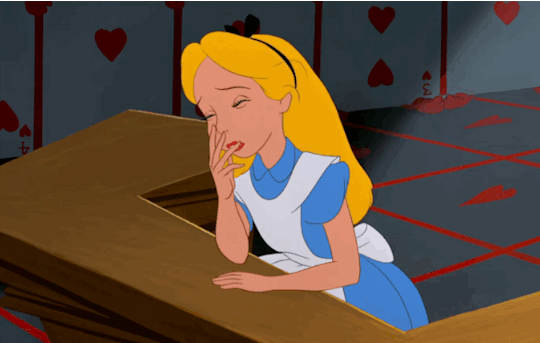
Good news. Stories have structure. Structure that can be learned. And a fantastic place to start learning structure?
Save the Cat: The Last Book on Screenwriting You’ll Ever Need by Blake Snyder. This book gives a simple outline that most stories follow. And as an introduction to story structure, it can’t be beat.

In Save the Cat, 15 plot points are spelled out in something called a beat sheet. During the outlining process, these “beats” or plot points can be used as an armature or skeleton that your story is built upon.
So what are those 15 plot points?
Opening Image: A snapshot of the hero’s problematic ordinary world, right before the story starts and changes everything.
Set-Up: Further establishing that ordinary world and what the hero does every day, impressing upon the audience or reader what’s wrong, and the idea that something needs to change.
Theme Stated: The truth that the hero will learn by experiencing the story, the statement that will be proven to the audience. But upon first encountering this truth, in this story beat right in the beginning, the hero doesn’t understand or outright refuses to believe it. The theme stated is asking a question, a question which the story will answer.
Catalyst: The ordinary world is shattered. Something unexpected happens, and this event triggers all the conflict and change of the whole story. Life will never be the same after this moment. This is the Call to Adventure.
Debate: But for a moment, the hero won’t be quite sure about answering that call. Leaving behind the ordinary world is difficult – even if the catalyst has come along and disrupted everything – because the ordinary means safety, it means not being challenged, it means avoiding conflict and heartache. Yes, that existence they’re stuck in might be stagnant and unpleasant, but it protects them from facing the intimidating task of growth, of becoming something better.
Break Into 2: And this is when the hero decides to answer the call and cross the threshold of act two, determined to pursue their goal.
B Story: This is when the relationship – which usually carries and proves the theme – starts in earnest.
Fun & Games: This is just what it says: the premise promised a certain type of pure entertainment, and this beat is where we get to experience it fully.
Midpoint: This is either a false victory or a false defeat. Something really really good happens. Or something the exact opposite.
Bad Guys Close In: Forces of opposition and conflict begin to converge on the hero and his goal. Everything begins to fall apart for the hero, the defeats piling up one after another, the main character punching back.
All Is Lost: This is the sequence where absolutely everything falls apart for the hero. The plans fail, the goal is lost, the mentor dies, the villain wins. All is, quite literally, lost.
Dark Night of the Soul: The hero’s bleakest moment is right here. In addition to all of the tangible things that have been lost, hope and the gumption to continue with the story have also vanished. There is usually a hint of death here, of some kind. An actual death, or an emotional or spiritual death.
Break into 3: Ah, but there’s a light at the end of the tunnel. Inspiration occurs, hope is rekindled, courage to pursue the story returns. Usually, this is the moment where the main character learns what they NEED, the truth which will heal them, and allow them to fix their own lives. With this, they are able to snatch victory from defeat.
Finale: And in here, the story goal is pursued once more, but this time from the stronger version of the hero – the version that has learned the theme, and committed to act accordingly.
Closing Image: The opposite of the opening image. This is a snapshot of life after the story, the problems of the ordinary world solved or banished, a new world opening up for the hero. If the opening is the equivalent of “once upon a time” this is saying “And every day after … “
So let’s see how that works! And to see it, let’s look at my favorite short film of all time – Paperman (because this gave me an excuse to watch it several times and listen to the music while writing it.)
1) Opening Image
We see George, a twenty-something in a sixty-something’s suit and tie, obviously on his way to work, and not looking at all enthused about it. He stares straight ahead, expression bored, lifeless, right on the edge of depressed. Wind from a passing train pushes him slightly, and he lets it, demeanor unchanging.
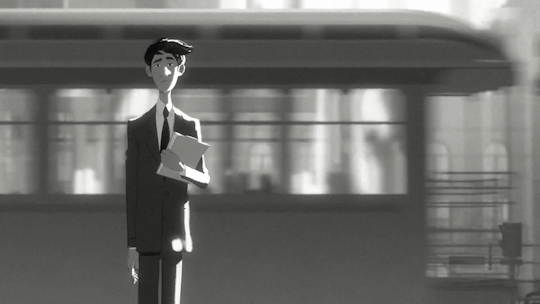
2) Set-Up
But then a sheet of paper, caught on the wind, hits his shoulder. The paper flies off again, and a young woman appears onscreen, chasing after the paper, as the surprised George watches.
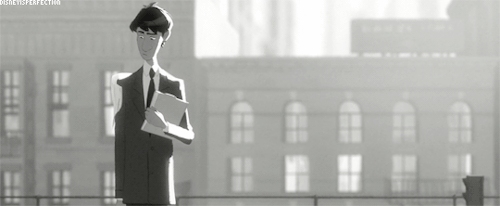
After catching it offscreen, the girl returns, tucking the paper into the stack she carries, smiling slightly. They both face forward, waiting for the train side-by-side, in silence. She’s glancing sideways at him, he’s smiling and fidgeting nervously, but still resolutely facing forward; they’re both aware of each other, seemingly hoping the other will be braver, but neither able to overcome their shyness and the unspoken rules of everyday life.

3) Theme Stated
As a train charges into the station, a paper from George’s stack is snatched by the wind and lands flat on the woman’s face. When he pulls the paper away, she laughs: her lipstick left a perfect kiss mark on the sheet. When George spots it, he laughs too …

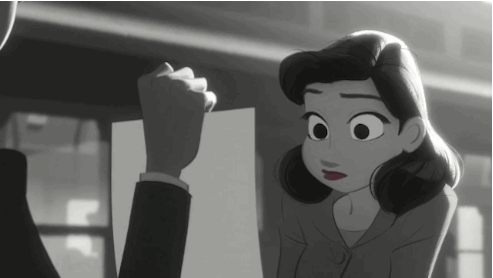
but when he opens his eyes, she’s gone. She’s boarded a different train. The kiss-mark paper flaps in the wind as the train begins to move, taking her away. He watches, crestfallen. She glances back. Looks of regret and disappointment are exchanged, both a little wistful. The paper, the symbol of their fleeting memorable meeting, waves goodbye.

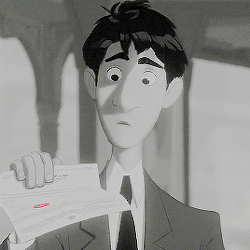
Through this little sequence of images, the question of the whole story is asked: Was there a connection between them? Will they find each other again? And on a wider level: What does it take to find love?
Further Set-Up:
And cut to George behind a desk, in a gray office, dark file cabinets towering behind him, clocks on the wall ticking away his life. Miserable again, he stares at the lipsticked paper. A stack of documents slams onto the desk from on high. The grim-faced boss of the office scowls down at him. George frowns at the stack, then at his boss, who stomps away.


4) Catalyst
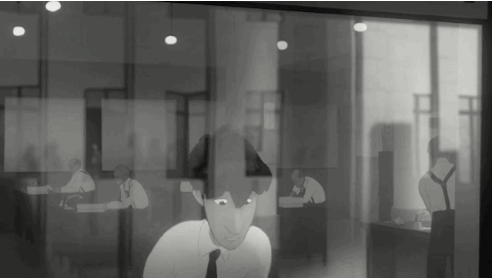
Breeze pulls the kissed paper off his desk and out the open window. He catches it just in time, breathing a sigh of relief. And then he sees something. The girl! She’s there! She’s right across the street!
5) Debate
He needs to get her attention! He dithers for a moment, then throws the window wide and enthusiastically waves his arms.

An ominous “ahem” from the boss brings him back inside, and back to his desk. But his attention is still on the girl, and the need to get her attention. He folds a paper airplane, stands before the window, poises the airplane to fly … but he glances at his boss’s office before he throws it. Should he?

6) Break Into Act 2
Yes. Yes, he should. He sends the little airplane messenger to bridge the distance between himself and the girl.
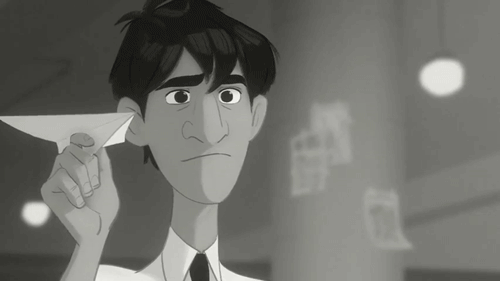
7) B Story
What he should have done while waiting for the train, he’s committed to do now. Talk to her. The relationship of the story has started officially.
8) Fun & Games
In this moment, he becomes the “paper man” of the title. He folds and throws paper airplane after paper airplane. The boss shows up, shoves him back and slams his window. George pauses until he’s gone, then just keeps sending airplanes. They sail over the street, but are intercepted or miss their mark every time.

9) Midpoint
He reaches for more paper … and knocks an empty tray off the desk. He’s run out. Except for one paper, the kissed one, the only one he’s held onto. With a determined look, he folds it precisely into an airplane, stands before the window, breathes to steady himself …

And the wind steals the airplane from his hand, sending it spiraling to the street below, George reaching out pointlessly. On top of this defeat, the girl leaves the office.
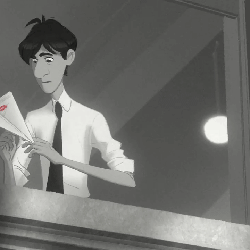
10) Bad Guys Close In
Immediately, the boss emerges from his lair. The other office workers hurriedly return to their scribbling, hunched to avoid drawing attention. The girl is leaving the building across the street! George turns from the window … and finds the boss looming above him, glowering, delivering another tall pile of meaningless work.

George sinks into his chair, defeated. But something happens as he watches his boss walk away, as he sees the office workers in neat rows; all of them older versions of George, reflections of what he will become … if he doesn’t do something right now.
He runs, sending paper from the perfect stacks flying in his wake.

11) All Is Lost
But when he escapes the building, and attempts to cross the street, cars nearly kill him. And when he finally makes it to the opposite sidewalk, the girl is nowhere in sight. She’s lost again.
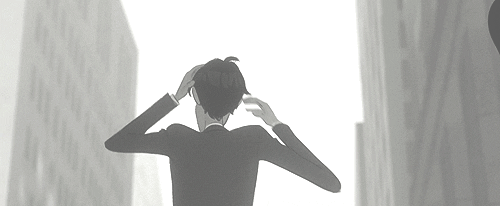
And all he manages to find is the little traitorous paper airplane. The paper he’d believed might mean something, might have signified something important and maybe a little magical. Which it obviously never did.
12) Dark Night of the Soul
Angry, he grabs the plane and throws it with all his strength. He’s lost his job, he’s lost the girl, he’s lost all faith in the magic he’d just started to believe might be real. He stomps towards the train station, returning home.

13) Break Into 3
But fate has other plans. The airplane glides over the city, almost supernaturally graceful and purposeful. It dives between buildings, and lands in the middle of the alley where all the paper planes have collected.

It sits immobile. Then it moves. Moves again. And jumps into flight. The airplane flies over the rest, stirring them into motion, into the air. In a place where not even a breath of wind could reach, there is now a whirlwind of George’s airplanes.

Though the forces of mediocrity tried to keep them apart, something greater has recognized George’s efforts and is going to see things through.
14) Finale
A parade of airplanes follows George down the street.
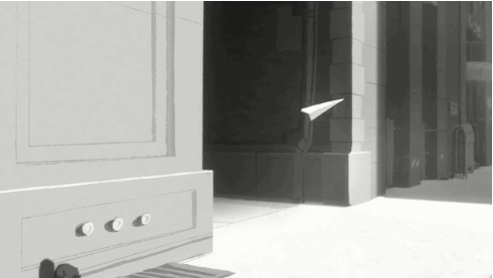
The leader attaches to his leg. He brushes it off, mad. A flurry of them attach to him, then carry him down the street, unfazed by his fighting.

The leader airplane rockets over the city purposefully, finds the girl, then lures her to follow.
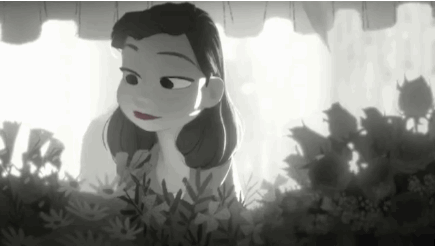
She chases after.

Somewhere else in the city, George is being pushed wherever the paper airplanes want him to go. We switch back and forth between George and the girl, as the airplanes push him and beckon her.
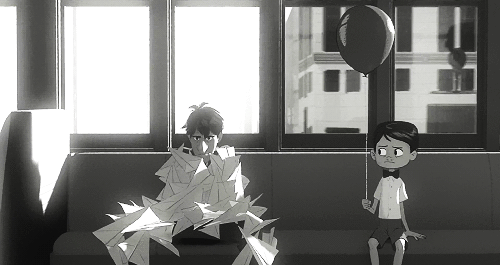

Until they’re both on different trains, which stop simultaneously, on opposite sides of the platform. The girl gets out. She fiddles with the airplane, like she’s trying to get it to work again. And just then, a breeze brings hundreds of paper planes skittering all around the platform.
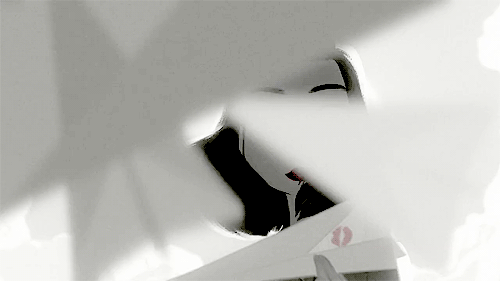
She looks up …
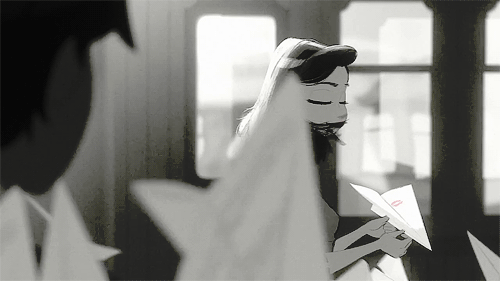
15) Closing Image
And there’s George, covered in paper planes.

He lurches towards Meg, and the airplanes falls away, their work done.

George and Meg face each other, smiling, the barriers of routine and shyness overcome. Exactly what should have happened, exactly what was meant to happen. Putting effort into connection and love prevailed in the end, defeating the allure of life spent in safety and mediocrity. The closing image is the opposite of the opening: he’s not alone, he’s not facing the train leading to his mundane job, he’s not looking miserable and hopeless. He’s facing the girl, his bright and meaningful new future. ***
So! Those are the 15 plot points. This is a fantastic way to begin learning what story structure is, why it works the way it does, and how to precisely pull it off.
For a more in-depth explanation, I highly recommend picking up a copy of Save the Cat. (It holds a special place in my heart; it was the first screenwriting book I ever read, and started obsessive study of storytelling.)
19K notes
·
View notes
Text
Character Development Tips
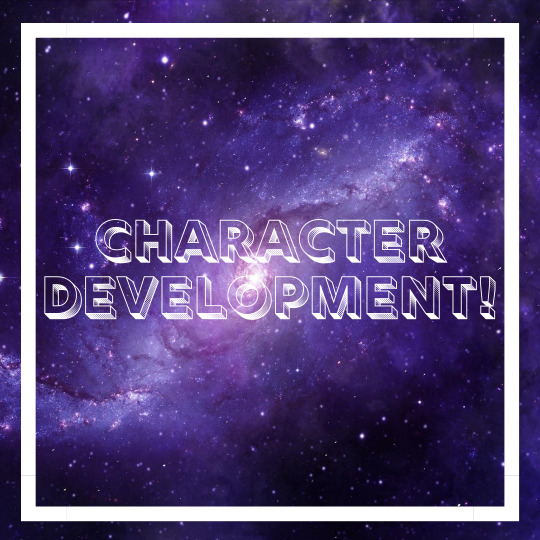
In the middle of June I decided to begin writing a novel. I’ll openly admit that this story was originally fan fiction. Following the long line of authors before me who have done the same. I barely associate the content I based this off of with the content I’m writing now and I had to make everything original. Gripping backstories, physical features, mannerism, speech, names (can you tell naming them was stressful yet?).
So how did I go about creating these characters (especially ones from other’s fiction)?
Well, for a lot of them I kept the basic traits that I originally saw in them. I expanded on the ones I liked best, did away with the ones that didn’t interest me and have added new ones throughout plotting the story.
A perfect example would be the one of the main character’s best friends. His original counterpart was weak-willed, apathetic, sweet, and blindly devoted.
I did away with weak-willed and apathetic, but kept sweet. His apathy turned to a floaty, hedonistic, wish-washiness that has to do with a strong belief in fate and astrology. His spinelessness turned into a temper that’s easily triggered when someone tries to hurt him, his friends or an innocent bystander.
His original counterpart has a fear of being left behind which I adapted into a high school setting, which became a fear that his friends might outgrow or replace him.
*Side tip!!*: This is the main character’s best friend (one of three, actually) and notice how not only have I given him personality traits, but an underlying fear that affects the story. Give your secondary character’s lives and motivations too! They don’t have to be big, just there.
But what if I’m starting from scratch?
Everyone makes characters differently. When starting from scratch, be creative and have fun, this is the fun part. Look at face claims on the internet and imagine a personality. Look at archetypes and tropes that interest you. How can you subvert them or build on them? (*this also helps you develop a concept!) Maybe you’ve already got some personality traits in mind, in that case...
Tip #1: Be discerning when picking traits.
The most important thing is to think about how these personality traits help and harm them throughout the story. If the trait doesn’t excite the reader (even if that reader is just you right now) or affect them throughout the story, it might not be necessary or it requires some tweaking.
My example: Cameron is a people-pleaser. It helps him because he’s able to quickly get into people’s good graces which he needs to do in the story, but it also harms him because he has trouble saying no to people and is easily manipulated. Both sides of this trait affect the story.
Tip #2: Their backstory should affect them now.
I’m guilty. I am a sucker for a sad backstory. Not that every backstory has to be sad, but it should affect who they are in the present story and, if you’re really crafty, who they’re going to be. Not every moment of their past should drive them, but certain incidents or one big incident should.
Tip #3: What’s their motive?
Give them a motive that supports their traits and actions throughout the story. Sometimes the motive comes before the trait even like in my example...
My example: Ava is a character in my novel who serves as a maternal figure. Although a minor character, when developing her I had to think about her motives, in her case, it’s to maintain the status quo within her house. Why? Because security means she can live the way she likes to. You see how, as a maternal figure, that’s a bit selfish. Ava’s insistence on keeping her home in order, might mean she spends a lot of time making sure it looks nice, making sure her family looks presentable.
If you were writing a character know that their traits, motives, and actions throughout the story all overlap.
As much as I talked about naming characters it’s getting pretty late and I’m pretty tired BUT here are some quick tips!!!
Naming your Characters
Use charts to help figure out what your character’s names are. For example, if you’re writing a historical fiction it might not hurt to look up the most popular names from that year.
Go with your character’s (or your) vibe. Sometimes a name just fits without rhyme or reason. That’s okay! Are they tough? Maybe name them Axel. Do they live in the country? Annabelle could work. Are they the moody, emo type? Try Ebony Dark’ness Dementia Raven Way.
Use name meanings. I personally love using name meanings. You don’t have to but if you’ve got some names in mind try looking them up and see if the meaning relates to who they are
PLEASE be culturally accurate. People get names all sorts of ways, maybe they named themselves, maybe they’re adopted, maybe they’re Cornelius Montgomery the Sixteenth. But please take the time to research your character’s race and ethnicity and see what names might be common. This applies for first and last names.
Ask a friend. Or heck name them after someone.
And because I love shamelessly talking about my characters here is an example or two:
Cameron’s name process was a lot less arduous than Zaire’s. Cameron is relatively plain. His name isn’t supposed to stand out and neither is he so I chose a fairly common first and middle name: Cameron Benjamin. It doesn’t stand out, and it’s relatively timeless. Also as an added bonus people who are close to him are shown because they call him “Cam.” If he had a name that was harder to shorten, I wouldn’t be able to have all those sweet, sweet moments. Note: I didn’t place a last name because I haven’t come up with one yet, sometimes it takes a minute and that’s okay. Keeping plugging away at other stuff.
Zaire’s name on the other hand...is a bit...extravagant. His full name is Zaire Apollo McClaine. Zaire’s first name doesn’t have a significant meaning but it sounds eerily similar to the word Sire. As the most popular kid in school, one could say the king of the school...You see what I did there. ;) Secondly, I wanted his first name to tell the reader something about him. Not to dance around it because I could write a whole rant about article titles like “Chinese Names that Make You Want to walk the Great Wall” or “Baby names for Black Panther Wakanda Lovers,” but you don’t commonly see a white person named Zaire and that’s the point. Sometimes a name should give an immediate clue about a crucial part of who they are.
Apollo also gives of a god-like connotation and points to the fact that his parent clearly have high aspirations for him with a name like Zaire Apollo. Also Apollo was the god of music (among many other things), and one of Zaire’s main interests is making music.
For his last name, McClaine, I wasn’t thinking of Zaire. I was thinking of his father Pierce McClaine. It suits him. Together Pierce McClaine sounds like a classic Hollywood name, but attached to Zaire Apollo you don’t get the same effect, which was intentional. This hints at their relationship, which is to say, Zaire doesn’t quite fit in with the rest of his family. So this wasn’t much of an update on what I did today so much as it was helping you all figure out character development, but that’s all good with me!!! I hope this helped.
Let me know what your character’s names and traits are and if you used any of these tips!!!
#writeblr#writing advice#character development#naming characters#novel writing#creative writing advice#writing tips#OCs#main character development#character design#creative writing
10 notes
·
View notes
Text
I kinda feel like cancel culture is making it harder for me to write flawed characters. I want them to make mistakes and be irrational sometimes, and learn from that stuff (or not depending on the severity of it) but there’s this weight like “why is your character arguing here when the other person is right?” when the answer is “because they’re not rational right now due to x y z” or something like that. I feel like I need to clarify in the writing exactly why a character is doing something to the point where it’s extremely “tell” and no “show” instead of letting the reader figure it out on their own.
I also just want to write characters that grow into better people but I’m scared of the readers who won’t move past the initial wrong-doings. Sometimes it seems like some people think if you’re not perfect now, then you never will be, and that applies to writing characters as well.
We praise Zuko’s redemption arc all the time, and I agree that it’s great. I just wonder if the reception would be the same if it aired today with no changes. If as many viewers would still forgive him.
This was kinda inspired by a discussion of a show I saw. In it, it was clear that the two opposing sides were meant to have good intentions with not-so-great executions of varying degrees. Their reasoning for what they did made sense for their characters, but from an objective standpoint you can see where the mistakes were made and what might have been the best outcome if they had done this and that instead. But a lot of people are watching this scene with this expectation that one side should be 100% right and the other 100% wrong rather than the complicated situation that it is. I loved the scene because it showed the characters behaving like they would, without being forced into a black and white discussion. But some people are still looking at it like it should be a black and white discussion, and then saying it’s bad writing because character x is stupid for not doing this, why wouldn’t they do this, completely ignoring the personality and experience of the character themself.
This ended up much longer than I intended it to be, and kinda lost focus. I guess I just want characters to be allowed to grow and make mistakes and be irrational (as long as that makes sense for them and isn’t a forced attempt to drive the story somewhere).
3K notes
·
View notes
Note
What are some good tips for getting started with writing a book? I have a concept but i can't put it into place.
Getting Started with Your Story
There’s no one way to start writing a book. For some people, it’s enough to just jump in and start writing to see where the story takes them. If you’re not too keen on that idea, then here is one process (as in, not the only process) that might help you move beyond your concept.

Concept ≠ Plot
Many writers mistake concept for plot, but they’re actually two very different things. A world where everyone grows up with superpowers is a concept; the plot is what you decide to write about within that concept - the specific characters and what happens to those characters; who your antagonist is and what conflict arises when that antagonist goes after what they want. All of these things contribute to your plot.
So first, define what it is you actually have at this particular point. Do you just have a concept? If so, you’ll need to take the necessary steps to develop that concept into a plot.
Concept >>> Plot
If you’ve decided that all you really have is a concept, then how do you take it and turn it into a plot? You brainstorm. All brainstorming really amounts to is expanding your ideas. All you’re doing is asking questions about the concept and delving deep into the answers.
The most simplistic way to start this process, especially if you’re struggling, is to ask one of two questions (or both, if applicable). These two questions: What could go wrong? What could go right?
Going back to my example about a world where everyone grows up with superpowers. If I were to ask the question “what could go wrong,” I’d end up with a whole list of possibilities.
The powers suddenly disappear
People start abusing their powers
Someone figures out how to steal powers
A hierarchy of strong vs. weak powers develops, creating superiority/inferiority dynamics
Someone is born without a superpower
There are many more possibilities I didn’t even think of here, but any one (or more) of these could become a plot. Choose one that sounds interesting, and then ask yourself “and then what?”
Say I choose: Someone figures out how to steal powers. Then what does that person do? Do they recruit people to do the dirty work for them? Do they work alone? Do they hoard these powers and barter them for other goods? Do they attempt to enslave people? Do they attempt to take control of institutions? What do they do?
Your goal is to take your ideas and turn them into actions taken by characters. People doing things. And each piece you add will usually lead into another. If you went with the idea that this character is stealing powers and essentially selling them for other goods, you’d have to ask yourself follow-up questions. First, who are they selling to? Why would anyone buy a new superpower if they already have one? What uses would they have for additional ones? What is the key demographic that this person is trying to reach? Secondly, what are they selling them in exchange for? Money? Favors? Souls? What is this character getting in return?
Now that you’ve examined potential actions that the character takes, you’ve also exposed potential new characters.
People they’re stealing from
People they’re bargaining with
People that try to police these crimes
People that try to copy this character’s process
At the beginning of this section, I talked about using “what could go right” as another optional jumping off point. This is a good path to follow if your concept is already really negative. For a concept where someone is killing people for some pointed reason, you might ask “what could go right” and explore ideas where the killer is caught and brought to justice.
The point of all this is to think about change as a means of taking your idea from concept to plot. A concept is static - it doesn’t move, evolve, or change. By developing a plot, you’re forcing the concept to be challenged in some way. If you think about it that way, you’ll be able to formulate conflicts, and the people that orchestrate and fight against those conflicts.
On that note, I think we’re ready to move onto the third piece of my graphic above.
Plot = Character Actions and Consequences
At this point, you have sketches for characters. You’ve got this nameless, faceless person that is stealing the powers, and all these other nameless, faceless people that I listed above. In essence, we have character concepts. And just like we turned our initial concept into a plot, we have to turn these character concepts into actual characters.
The basics are the easiest way to start. You figure out their name, their gender identity, their age, their appearance, some brief backstory and personality traits. I personally prefer the simplest questionnaire that I put together back in the early days because it hits on the poignant pieces of a character without overwhelming you with 100s of questions.
Now that you’ve given your character concepts names and faces and potential behaviors, you start to consider how one character’s view of the world inspires them to take certain actions, and you then think about how those actions affect your entire story.
We already kind of talked about the motives of the power thief in our example, but definitely delve deep here. On the surface, this character seems bad - stealing from people and then selling what they steal. But depending on what it is they’re getting in return, could we not argue that this character is a supernatural Robin Hood? Maybe instead of selling, they’re giving, and maybe the characters they’re stealing powers from are people that abuse and misuse their powers. Character motives can take a plot and turn it on its head, forcing you to reconceptualize everything. And that’s okay! That’s part of the process.
But separate from that idea, if we have a character concept of someone whose powers were stolen, and after developing their basic backstory, we discover that person’s name is Rose, and she has an especially close relationship with her brother. So when her powers are stolen, how does this affect her life? Was she using her powers to keep her brother alive and protected? What she using them to keep a roof over their heads? Was she using them as part of her job, as a means of providing? What happens to her life when her powers are stolen? And what will Rose do about it? Whatever Rose does will impact the story. If she does nothing to get her powers back, how does she solve her problems and does that make for a good story? If she does decide to act, then you’ve moved onto a new plot point to dive deeper into.
My point is, character concepts come from plots, but characters themselves often create plot, as their decisions and mistakes and successes create new outcomes. So if I could modify my original flow chart:

Before you develop something, you conceptualize it. You have a concept, then you make it a plot. You have concepts for characters, then you make them characters. And those characters end up driving your plot, to the point that this happens:

Plot inspires character. Character inspires plot. And it just keeps going around and around and around. Breaking it down into these pieces helps organize the process, but developing a story is rarely this neat and tidy. You’ll get ideas that don’t make sense, ideas that aren’t cohesive, characters you don’t need, characters that piss you off, problems you can’t solve, or plot points you’ve committed to that you no longer like…it will be messy. But it’s your mess, and the more you work on developing your own process, the more it’ll make sense to you. And it’ll become easier to know how to go about fixing it when something’s not right.
Have fun with this process! It’s supposed to be fun. When the pieces start to become clearer, you’re able to put them together in a rough outline. And once you have a rough outline, you can start writing, and really see it take shape.
-Rebekah
5K notes
·
View notes
Note
I’ve been writing since I was 10 years old. From October 2019 to May 2020, I didn’t write. It was the longest I’d ever gone without feeling the urge to write. I felt like I hit a wall where I just wasn’t improving anymore. I always considered myself a writer, everyone told me I was a writer, so when I wasn’t...I had no idea who I was. I had no idea I was so attached to the label “writer” until I didn’t feel like I deserved it anymore. That’s when I started reading. I say, still engaged in creative things through reading and watching TV. Maybe you’re done writing for good, it happens, maybe you’re just down and out at the moment, but don’t cast away stories that aren’t yours. The inspiration may come back, and if it doesn’t maybe you’ll find a new hobby along the way.
As OP says, don’t despair. It’s hard and I felt restless and awful and listless, but be patient with yourself. Be kind to yourself. You’ll end up where you’re supposed to be, and if you feel like you aren’t, remember you’ll get there one day.
Do you have any advice on what to do if you lose your joy and interest in writing when a writer was how you identified yourself?
(wry look) Life just pulled one of those cute things where I had three-quarters of a response written and I hit the wrong keys somehow and it all went away. Which tells me that this is important. So let me recreate it.
The best advice I’ve got for you right now is to lean back and wait, because normally the joy and interest will come back. Being a writer, and having enjoyed and been interested in it previously, isn’t something that goes away all that easily. The set of behaviors that make up being a writer are complex and difficult to ingrain… which is going to make the ability to do this kind of work difficult to lose even if you were trying to do so. So, first of all: take heart.
Now it has to be said that, human nature and psychology (and nature itself) being the cranky intransigent things they sometimes are, it may (paradoxically) be necessary for your recovery of your joy and interest in the work to completely surrender to the concept that you might actually have permanently lost it. I know this sounds counterintuitive, but the effectiveness of simply giving up is sometimes surprising. There’s a saying attributed to Carl Jung, the father of the concept of Archetype as we now understand it, that goes like this: “What you resist, persists; and not only does it persist, but it gets bigger in size.” (There’s a good long article about this concept over here in Psychology Today: worth looking at. …Though I also have to say that the illo at the top is hilarious and perfect, because Kylo Ren should frankly be the poster child for the whole idea.)
My own experience suggests that there are times when as soon as you give up, the thing that’s been eluding you either collapses to the ground where you can just stroll over and reclaim it, or turns around and runs headlong into your arms. Frustrating, but what can you do? When the whole point is to get whatever it is back, the idea that it played you a little in the process will after the fact seem less of an issue.
Possible causes for what’s going on with you are worth touching on briefly. I’ve had occasion to post a number of times about something that C. S. Lewis codified in The Screwtape Letters as “the Law of Undulations”. Now as much as I love him, there would be a lot of things that Clive and I would disagree about, but this wouldn’t be one of them. I think he was really onto something. So take a look at that basic post, and then we can move on a bit.
With the Law in mind, while you’re working on what “giving up” might look like – assuming you need to go that far – here are some possibly similar situations and strategies to consider.
Having a dry spell and trying to get the few ideas that are available written.
Losing your confidence and feeling like you’ve got nothing worth writing.
Having lots of ideas but “freezing” when attempting to actually get the writing done.
Not being able to write as a side effect of absolutely everything in life going wrong. (AKA a broader version of the John Watson cri de coeur: “It is what it is, and what it is is shit.”)
Some of the above situations come with suggestions of possible things you can do about them. But do not underestimate the power of simply waiting a while and not doing anything. It’s worth emphasizing that in our culture as it stands at the moment, there’s endless emphasis on immediately DOING THINGS to fix what ails you. Sometimes not doing anything is more effective – though to some people that’s going to sound heretical, and you’ll run the risk of being accused of laziness (not least by the back of your own mind, once it realizes you’re onto something that’s going to give you back control of the situation. The self-sabotaging wiliness of a subconscious about to lose its advantage can be a terrifying thing… but even that loses some of its terrors when your conscious mind suspects or knows what it’s up to.) Anyway, ignore that noise.
Give doing nothing a good long chance. Stoke up on your reading. Get caught up on TV and movies if that’s your thing. Do other work. Create something that isn’t writing. (Cooking’s good for this. I love being responsible for mighty successes or godawful failures in the kitchen and knowing that the critics at Kirkus and PW are not going to give the slightest damns about it.)
But tl:dr; Don’t despair: just kick back and wait. And see how it goes.
…And eventually let me know how you get on. :) HTH.
730 notes
·
View notes
Text
I think my writing is improving as I stop asking myself “is this good enough?” and start asking myself “is this honest? Is this true to me?”
“Good” is so arbitrary, but the harder I focus on being honest over being good I think the quality improves and connects more genuinely with people
7K notes
·
View notes
Text
Announcement from the Mod: I’m writing a novel!!!!!
I know I only have one follower at the moment, but I’m hoping to grow along on the platform as I post more. Quarantine has been pretty rough on me mentally (to the people that read this I hope you’re doing well) but I want to use this time to get creative again. As someone who suffers from ADHD and depression, two mental illnesses that make it hard to accomplish anything, I’d like to prove to myself I can do this. As previously mentioned, one of the reasons quarantine has taken such a toll on my mental health is that I’m somewhat alone. Which means I’d be writing this novel alone. I had no community to share this with. Whether I’m successful or I fail, whether I’m proud of something or absolutely hate every word I’ve just written, so obviously the most rational decision is to take it to social media. I hope you guys enjoy this journey I’m about to go on and I hope if I can offer any cool tips or tricks, you can at least relate.
Answering some questions
Q: What will you get from me? A: Updates about my writing process Relatable venting about writing and mental health Moodboards Playlists Snippets and break downs of scenes I’ve written that I enjoy Q: Am I still doing book reviews? A: Well, I only did one, but I intend to do more. I read fairly slow so expect one a month give or take depending on my life, mental health, and the length of the book.
Q: What is my novel about? What genre? A: It’s an LGBT+ YA novel about two high school students named Cameron and Zaire. Without giving away too much, Zaire wants to show Cameron the outside world is safe. While Cameron helps Zaire cope with his struggles at home. Q: Where will I publish this story? A: Right now it’s more about finishing it, but I have given it some thought and I will most likely put it up on Wattpad. If anyone has any suggestion of places to put your writing and still keep all your creative rights I’m happy to take them!!!
If I think of any more I’ll write them down here but for now, it’s quite late. I’m excited for what the future brings!!!
1 note
·
View note
Text
Fantasy Guide to Architecture



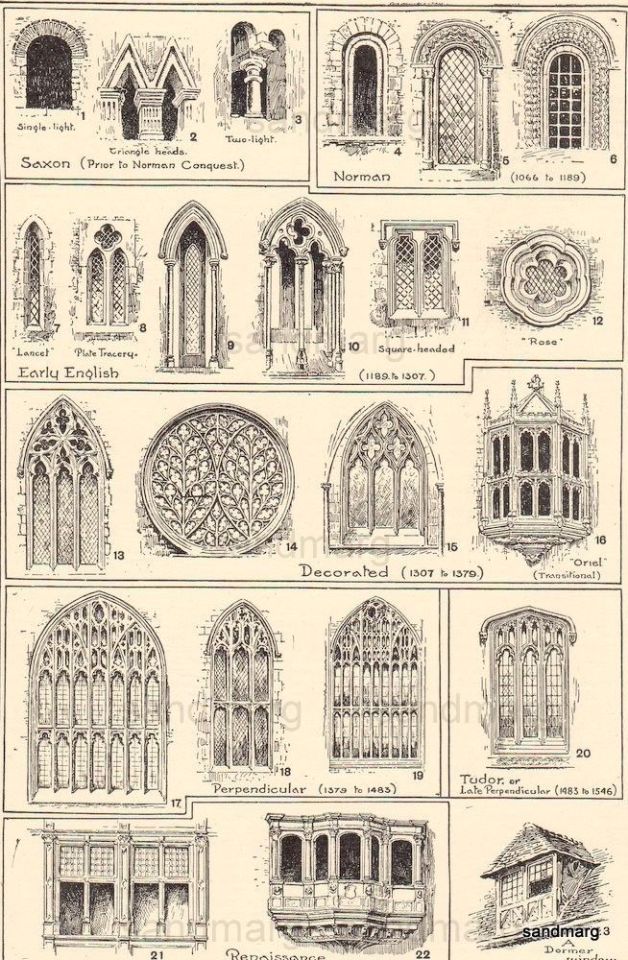


This post has been waiting on the back burner for weeks and during this time of quarantine, I have decided to tackle it. This is probably the longest post I have ever done. I is very tired and hope that I have covered everything from Ancient times to the 19th Century, that will help you guys with your worldbuilding.
Materials
What you build with can be determined by the project you intend, the terrain you build on and the availability of the material. It is one characteristic that we writers can take some some liberties with.
Granite: Granite is an stone formed of Igneous activity near a fissure of the earth or a volcano. Granites come in a wide range of colour, most commonly white, pink, or grey depending on the minerals present. Granite is hard and a durable material to build with. It can be built with without being smoothed but it looks bitchin' and shiny all polished up.
Marble: Probably everyone's go to materials for building grand palaces and temples. Marble is formed when great pressure is placed on limestone. Marble can be easily damaged over time by rain as the calcium in the rock dissolves with the chemicals found in rain. Marble comes in blue, white, green, black, white, red, gray and yellow. Marble is an expensive material to build with, highly sought after for the most important buildings. Marble is easy to carve and shape and polishes to a high gleam. Marble is found at converging plate boundaries.
Obsidian: Obsidian is probably one of the most popular stones mentioned in fantasy works. Obsidian is an igneous rock formed of lava cooling quickly on the earth's surfaces. Obsidian is a very brittle and shiny stone, easy to polish but not quite a good building material but a decorative one.
Limestone: Limestone is made of fragments of marine fossils. Limestone is one of the oldest building materials. Limestone is an easy material to shape but it is easily eroded by rain which leads most limestone monuments looking weathered.
Concrete: Concrete has been around since the Romans. Concrete is formed when aggregate (crushed limstone, gravel or granite mixed with fine dust and sand) is mixed with water. Concrete can be poured into the desired shape making it a cheap and easy building material.
Brick: Brick was one of history's most expensive materials because they took so long to make. Bricks were formed of clay, soil, sand, and lime or concrete and joined together with mortar. The facade of Hampton Court Palace is all of red brick, a statement of wealth in the times.
Glass: Glass is formed of sand heated until it hardens. Glass is an expensive material and for many years, glass could not be found in most buildings as having glass made was very expensive.
Plaster: Plaster is made from gypsum and lime mixed with water. It was used for decoration purposes and to seal walls. A little known fact, children. Castle walls were likely painted with plaster or white render on the interior.
Wattle and Daub: Wattle and daub is a building material formed of woven sticks cemented with a mixture of mud, one of the most common and popular materials throughout time.
Building terms
Arcade: An arcade is a row of arches, supported by columns.
Arch: An arch is a curved feature built to support weight often used for a window or doorway.
Mosaic: Mosaics are a design element that involves using pieces of coloured glass and fitted them together upon the floor or wall to form images.
Frescos: A design element of painting images upon wet plaster.
Buttress: A structure built to reinforce and support a wall.
Column: A column is a pillar of stone or wood built to support a ceiling. We will see more of columns later on.
Eave: Eaves are the edges of overhanging roofs built to allow eater to run off.
Vaulted Ceiling: The vaulted ceilings is a self-supporting arched ceiling, than spans over a chamber or a corridor.
Colonnade: A colonnade is a row of columns joined the entablature.
Entablature: a succession of bands laying atop the tops of columns.
Bay Window: The Bay Window is a window projecting outward from a building.
Courtyard/ Atrium/ Court: The courtyard is an open area surrounded by buildings on all sides
Dome: The dome resembles a hollow half of a sphere set atop walls as a ceiling.
Façade: the exterior side of a building
Gable: The gable is a triangular part of a roof when two intersecting roof slabs meet in the middle.
Hyphen: The hyphen is a smaller building connecting between two larger structures.
Now, let's look at some historical building styles and their characteristics of each Architectural movement.
Classical Style
The classical style of Architecture cannot be grouped into just one period. We have five: Doric (Greek), Ionic (Greek), Corinthian (Greek), Tuscan (Roman) and Composite (Mixed).
Doric: Doric is the oldest of the orders and some argue it is the simplest. The columns of this style are set close together, without bases and carved with concave curves called flutes. The capitals (the top of the column) are plain often built with a curve at the base called an echinus and are topped by a square at the apex called an abacus. The entablature is marked by frieze of vertical channels/triglyphs. In between the channels would be detail of carved marble. The Parthenon in Athens is your best example of Doric architecture.
Ionic: The Ionic style was used for smaller buildings and the interiors. The columns had twin volutes, scroll-like designs on its capital. Between these scrolls, there was a carved curve known as an egg and in this style the entablature is much narrower and the frieze is thick with carvings. The example of Ionic Architecture is the Temple to Athena Nike at the Athens Acropolis.
Corinthian: The Corinthian style has some similarities with the Ionic order, the bases, entablature and columns almost the same but the capital is more ornate its base, column, and entablature, but its capital is far more ornate, commonly carved with depictions of acanthus leaves. The style was more slender than the others on this list, used less for bearing weight but more for decoration. Corinthian style can be found along the top levels of the Colosseum in Rome.
Tuscan: The Tuscan order shares much with the Doric order, but the columns are un-fluted and smooth. The entablature is far simpler, formed without triglyphs or guttae. The columns are capped with round capitals.
Composite: This style is mixed. It features the volutes of the Ionic order and the capitals of the Corinthian order. The volutes are larger in these columns and often more ornate. The column's capital is rather plain. for the capital, with no consistent differences to that above or below the capital.
Islamic Architecture
Islamic architecture is the blanket term for the architectural styles of the buildings most associated with the eponymous faith. The style covers early Islamic times to the present day. Islamic Architecture has some influences from Mesopotamian, Roman, Byzantine, China and the Mongols.
Paradise garden: As gardens are an important symbol in Islam, they are very popular in most Islamic-style buildings. The paradise gardens are commonly symmetrical and often enclosed within walls. The most common style of garden is split into four rectangular with a pond or water feature at the very heart. Paradise gardens commonly have canals, fountains, ponds, pools and fruit trees as the presence of water and scent is essential to a paradise garden.
Sehan: The Sehan is a traditional courtyard. When built at a residence or any place not considered to be a religious site, the sehan is a private courtyard. The sehan will be full of flowering plants, water features snd likely surrounded by walls. The space offers shade, water and protection from summer heat. It was also an area where women might cast off their hijabs as the sehan was considered a private area and the hijab was not required. A sehan is also the term for a courtyard of a mosque. These courtyards would be surrounded by buildings on all sides, yet have no ceiling, leaving it open to the air. Sehans will feature a cleansing pool at the centre, set under a howz, a pavilion to protect the water. The courtyard is used for rituals but also a place of rest and gathering.
Hypostyle Hall: The Hypostyle is a hall, open to the sky and supported by columns leading to a reception hall off the main hall to the right.
Muqarnas : Muqarnas is a type of ornamentation within a dome or a half domed, sometimes called a "honeycomb", or "stalactite" vaulted ceiling. This would be cast from stone, wood, brick or stucco, used to ornament the inside of a dome or cupola. Muqarnas are used to create transitions between spaces, offering a buffer between the spaces.
African Architecture
African Architecture is a very mixed bag and more structurally different and impressive than Hollywood would have you believe. Far beyond the common depictions of primitive buildings, the African nations were among the giants of their time in architecture, no style quite the same as the last but just as breathtaking.
Somali architecture: The Somali were probably had one of Africa's most diverse and impressive architectural styles. Somali Architecture relies heavy on masonry, carving stone to shape the numerous forts, temples, mosques, royal residences, aqueducts and towers. Islamic architecture was the main inspiration for some of the details of the buildings. The Somali used sun-dried bricks, limestone and many other materials to form their impressive buildings, for example the burial monuments called taalo
Ashanti Architecture: The Ashanti style can be found in present day Ghana. The style incorporates walls of plaster formed of mud and designed with bright paint and buildings with a courtyard at the heart, not unlike another examples on this post. The Ashanti also formed their buildings of the favourite method of wattle and daub.
Afrikaner Architecture: This is probably one of the oddest architectural styles to see. Inspired by Dutch settlers (squatters), the buildings of the colony (planters/squatters) of South Africa took on a distinctive Dutch look but with an Afrikaner twist to it making it seem both familiar and strange at the same time.
Rwandan Architecture: The Rwandans commonly built of hardened clay with thatched roofs of dried grass or reeds. Mats of woven reeds carpeted the floors of royal abodes. These residences folded about a large public area known as a karubanda and were often so large that they became almost like a maze, connecting different chambers/huts of all kinds of uses be they residential or for other purposes.
Aksumite Architecture: The Aksumite was an Empire in modern day Ethiopia. The Aksumites created buildings from stone, hewn into place. One only has to look at the example of Bete Medhane Alem to see how imposing it was.
Yoruba Architecture: Yoruba Architecture was made by earth cured until it hardened enough to form into walls, or they used wattle and daub, roofed by timbers slats coated in woven grass or leaves. Each unit divided up parts of the buildings from facilities to residences, all with multiple entrances, connected together.
Igbo Architecture: The Igbo style follows some patterns of the Yoruba architecture, excepting that there are no connected walls and the spacing is not so equal. The closer a unit was to the centre, the more important inhabitants were.
Hausa architecture: Hausa Architecture was formed of monolithic walls coated in plaster. The ceilings and roof of the buildings were in the shape of small domes and early vaulted ceilings of stripped timber and laterite. Hausa Architecture features a single entrance into the building and circular walls.
Nubian Architecture: Nubia, in modern day Ethiopia, was home to the Nubians who were one of the world's most impressive architects at the beginning of the architecture world and probably would be more talked about if it weren't for the Egyptians building monuments only up the road. The Nubians were famous for building the speos, tall tower-like spires carved of stone. The Nubians used a variety of materials and skills to build, for example wattle and daub and mudbrick. The Kingdom of Kush, the people who took over the Nubian Empire was a fan of Egyptian works even if they didn't like them very much. The Kushites began building pyramid-like structures such at the sight of Gebel Barkal
Egyptian Architecture: The Egyptians were the winners of most impressive buildings for s good while. Due to the fact that Egypt was short on wood, Ancient Egyptians returned to building with limestone, granite, mudbrick, sandstone which were commonly painted with bright murals of the gods along with some helpful directions to Anubis's crib. The Egyptians are of course famous for their pyramids but lets not just sit on that bandwagon. Egyptian Architecture sported all kinds of features such as columns, piers, obelisks and carving buildings out of cliff faces as we see at Karnak. The Egyptians are cool because they mapped out their buildings in such a way to adhere to astrological movements meaning on special days if the calendar the temple or monuments were in the right place always. The Egyptians also only build residences on the east bank of the Nile River, for the opposite bank was meant for the dead. The columns of Egyptian where thicker, more bulbous and often had capitals shaped like bundles of papyrus reeds.
Chinese Architecture
Chinese Architecture is probably one of the most recognisable styles in the world. The grandness of Chinese Architecture is imposing and beautiful, as classical today as it was hundreds of years ago.
The Presence of Wood: As China is in an area where earthquakes are common, most of the buildings are were build of wood as it was easy to come across and important as the Ancient Chinese wanted a connection to nature in their homes.
Overhanging Roofs: The most famous feature of the Chinese Architectural style are the tiled roofs, set with wide eaves and upturned corners. The roofs were always tiled with ceramic to protect wood from rotting. The eaves often overhung from the building providing shade.
Symmetrical Layouts: Chinese Architecture is symmetrical. Almost every feature is in perfect balance with its other half.
Fengshui: Fengshui are philosophical principles of how to layout buildings and towns according to harmony lain out in Taoism. This ensured that the occupants in the home where kept in health, happiness, wealth and luck.
One-story: As China is troubled by earthquakes and wood is not a great material for building multi-storied buildings, most Chinese buildings only rise a single floor. Richer families might afford a second floor but the single stories compounds were the norm.
Orientation: The Ancient Chinese believed that the North Star marked out Heaven. So when building their homes and palaces, the northern section was the most important part of the house and housed the heads of the household.
Courtyards: The courtyard was the most important area for the family within the home. The courtyard or siheyuan are often built open to the sky, surrounded by verandas on each side.
Japanese Architecture
Japanese Architecture is famous for its delicacy, smooth beauty and simplistic opulence. Japanese Architecture has been one of the world's most recognisable styles, spanning thousands of years.
Wood as a Common Material: As with the Chinese, the most popular material used by the Japanese is wood. Stone and other materials were not often used because of the presence of earthquakes. Unlike Chinese Architecture, the Japanese did not paint the wood, instead leaving it bare so show the grain.
Screens and sliding doors: The shoji and fusuma are the screens and sliding doors are used in Japanese buildings to divide chambers within the house. The screens were made of light wood and thin parchment, allowing light through the house. The screens and sliding doors were heavier when they where used to shutter off outside features.
Tatami: Tatami mats are used within Japanese households to blanket the floors. They were made of rice straw and rush straw, laid down to cushion the floor.
Verandas: It is a common feature in older Japanese buildings to see a veranda along the outside of the house. Sometimes called an engawa, it acted as an outdoor corridor, often used for resting in.
Genkan: The Genkan was a sunken space between the front door and the rest of the house. This area is meant to separate the home from the outside and is where shoes are discarded before entering.
Nature: As both the Shinto and Buddhist beliefs are great influences upon architecture, there is a strong presence of nature with the architecture. Wood is used for this reason and natural light is prevalent with in the home. The orientation is meant to reflect the best view of the world.
Indian Architecture
India is an architectural goldmine. There are dozens of styles of architecture in the country, some spanning back thousands of years, influenced by other cultures making a heady stew of different styles all as beautiful and striking as the last.
Mughal Architecture: The Mughal architecture blends influences from Islamic, Persian along with native Indian. It was popular between the 16th century -18th century when India was ruled by Mughal Emperors. The Taj Mahal is the best example of this.
Indo-Saracenic Revival Architecture: Indo Saracenic Revival mixes classical Indian architecture, Indo-Islamic architecture, neo-classical and Gothic revival of the 1800s.
Cave Architecture: The cave architecture is probably one of the oldest and most impressive styles of Indian architecture. In third century BC, monks carved temples and buildings into the rock of caves.
Rock-Cut Architecture: The Rock-cut is similar to the cave style, only that the rock cut is carved from a single hunk of natural rock, shaped into buildings and sprawling temples, all carved and set with statues.
Vesara Architecture: Vesara style prevalent in medieval period in India. It is a mixture of the Dravida and the Nagara styles. The tiers of the Vesara style are shorter than the other styles.
Dravidian Architecture: The Dravidian is the southern temple architectural style. The Kovils are an example of prime Dravidian architecture. These monuments are of carved stone, set up in a step like towers like with statues of deities and other important figures adorning them.
Kalinga Architecture: The Kalinga style is the dominant style in the eastern Indian provinces. The Kalinga style is famous for architectural stipulations, iconography and connotations and heavy depictions of legends and myths.
Sikh Architecture: Sikh architecture is probably the most intricate and popular of the styles here. Sikh architecture is famous for its soft lines and details.
Romanesque (6th -11th century/12th)
Romanesque Architecture is a span between the end of Roman Empire to the Gothic style. Taking inspiration from the Roman and Byzantine Empires, the Romanesque period incorporates many of the styles.
Rounded arches: It is here that we see the last of the rounded arches famous in the classical Roman style until the Renaissance. The rounded arches are very popular in this period especially in churches and cathedrals. The rounded arches were often set alongside each other in continuous rows with columns in between.
Details: The most common details are carved floral and foliage symbols with the stonework of the Romanesque buildings. Cable mouldings or twisted rope-like carvings would have framed doorways.
Pillars: The Romanesque columns is commonly plainer than the classical columns, with ornate captials and plain bases. Most columns from this time are rather thick and plain.
Barrel Vaults: A barrel vaulted ceiling is formed when a curved ceiling or a pair of curves (in a pointed ceiling). The ceiling looks rather like half a tunnel, completely smooth and free of ribs, stone channels to strengthen the weight of the ceiling.
Arcading: An arcade is a row of arches in a continual row, supported by columns in a colonnade. Exterior arcades acted as a sheltered passage whilst inside arcades or blind arcades, are set against the wall the arches bricked, the columns and arches protruding from the wall.
Gothic Architecture (12th Century - 16th Century)
The Gothic Architectural style is probably one of the beautiful of the styles on this list and one of most recognisable. The Gothic style is a dramatic, opposing sight and one of the easiest to describe.
Pointed arch: The Gothic style incorporates pointed arches, in the windows and doorways. The arches were likely inspired by pre-Islamic architecture in the east.
Ribbed vault: The ribbed vault of the Gothic age was constructed of pointed arches. The trick with the ribbed vaulted ceiling, is that the pointed arches and channels to bear the weight of the ceiling.
Buttresses: The flying buttress is designed to support the walls. They are similar to arches and are connected to counter-supports fixed outside the walls.
Stained-Glass Window: This is probably one of the most recognisable and beautiful of the Gothic features. They can be set in round rose windows or in the pointed arches.
Renaissance Architecture (15th Century- 17th Century)
Renaissance architecture was inspired by Ancient Roman and Greek Architecture. Renaissance Architecture is Classical on steroids but has its own flare. The Renaissance was a time for colour and grandeur.
Columns and pilasters: Roman and Greek columns were probably the greatest remix of the Renaissance period. The architecture of this period incorporated the five orders of columns are used: Tuscan, Doric, Ionic, Corinthian and Composite. The columns were used to hold up a structure, support ceilings and adorn facades. Pilasters were columns within a chamber, lining the walls for pure decoration purposes.
Arches: Arches are rounded in this period, having a more natural semi-circular shape at its apex. Arches were a favourite feature of the style, used in windows, arcades or atop columns.
Cupola: Is a small dome-like tower atop a bigger dome or a rooftop meant to allow light and air into the chamber beneath.
Vaulted Ceiling/Barrel Vault: Renaissance vaulted ceilings do not have ribs. Instead they are semi-circular in shape, resting upon a square plain rather than the Gothic preference of rectangular. The barrel vault held by its own weight and would likely be coated in plaster and painted.
Domes: The dome is the architectural feature of the Renaissance. The ceiling curves inwards as it rises, forming a bowl like shape over the chamber below. The dome's revival can be attributed to Brunelleschi and the Herculean feat of placing a dome on the Basilica di Santa Maria del Fiore. The idea was later copied by Bramante who built St. Peter's Basilica.
Frescos: To decorate the insides of Renaissance buildings, frescos (the art of applying wet paint to plaster as it dries) were used to coat the walls and ceilings of the buildings. The finest frescos belong to Michelangelo in the Sistine Chapel.
Baroque (1625–1750)
Baroque incorporates some key features of Renaissance architecture, such as those nice columns and domes we saw earlier on. But Baroque takes that to the next level. Everything is higher, bigger, shinier, brighter and more opulent. Some key features of Baroque palaces and buildings would be:
Domes: These domes were a common feature, left over from the Renaissance period. Why throw out a perfectly good bubble roof, I ask you? But Baroque domes were of course, grander. Their interiors were were nearly always painted or gilded, so it drew the eye upwards which is basically the entire trick with Baroque buildings. Domes were not always round in this building style and Eastern European buildings in Poland and Ukraine for example sport pear-shaped domes.
Solomonic columns: Though the idea of columns have been about for years but the solomonic columns but their own twist on it. These columns spiral from beginning to end, often in a s-curved pattern.
Quadratura: Quadratura was the practice of painting the ceilings and walls of a Baroque building with trompe-l'oeil. Most real life versions of this depict angels and gods in the nude. Again this is to draw the eye up.
Mirrors: Mirrors came into popularity during this period as they were a cool way to create depth and light in a chamber. When windows faced the mirrors on the wall, it creates natural light and generally looks bitchin'. Your famous example is the Hall of Mirrors at the Palace of Versailles.
Grand stairways: The grand sweeping staircases became popular in this era, often acting as the centre piece in a hall. The Baroque staircase would be large and opulent, meant for ceremonies and to smoother guests in grandeur.
Cartouche: The cartouche is a design that is created to add some 3D effect to the wall, usually oval in shape with a convex surface and edged with scrollwork. It is used commonly to outline mirrors on the wall or crest doorways just to give a little extra opulence.
Neoclassical (1750s-19th century)
The Neoclassical Period involved grand buildings inspired by the Greek orders, the most popular being the Doric. The main features of Neoclassical architecture involve the simple geometric lines, columns, smooth walls, detailing and flat planed surfaces. The bas-reliefs of the Neoclassical style are smoother and set within tablets, panels and friezes. St. Petersburg is famous for the Neoclassical styles brought in under the reign of Catherine the Great.
Greek Revival (late 18th and early 19th century)
As travel to other nations became easier in this time period, they became to get really into the Ancient Greek aesthetic. During this architectural movement they brought back the gabled roof, the columns and the entablature. The Greek Revival was more prevalent in the US after the Civil War and in Northern Europe.
Hope this helps somewhat @marril96
27K notes
·
View notes